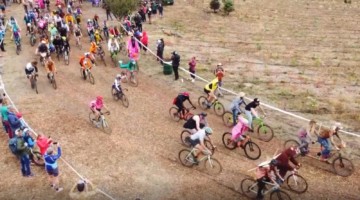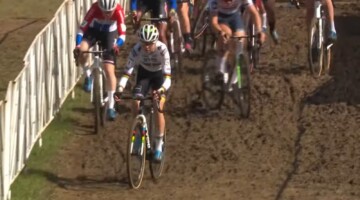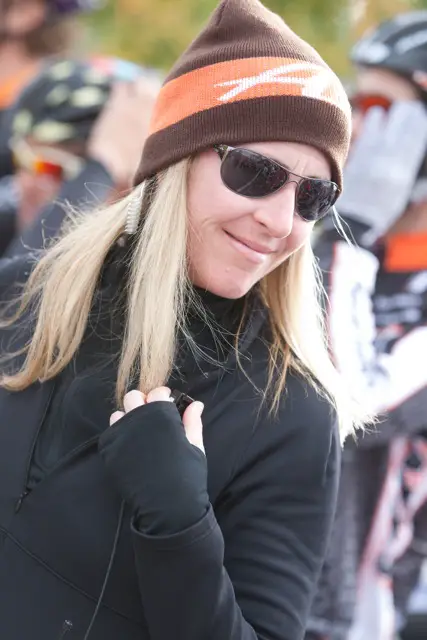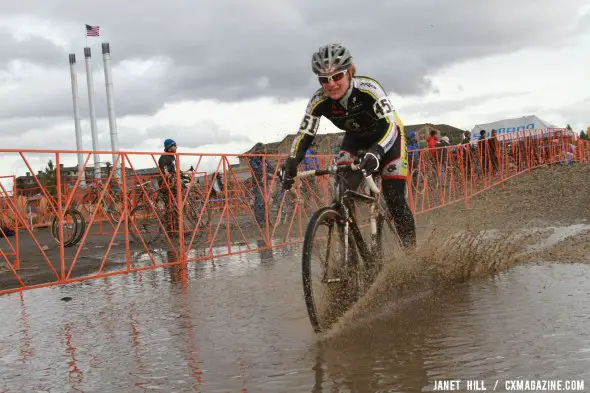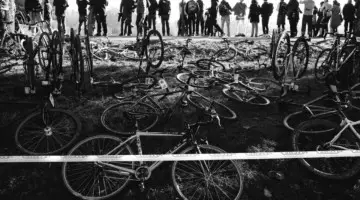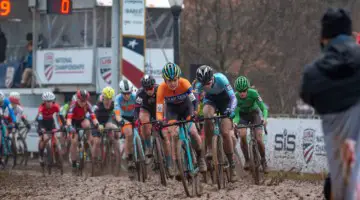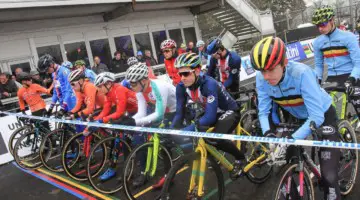We recently caught up with Joan Hanscom, event director of the USGP series and a key part of the team bringing both Masters (2012 and 13) and Elite Worlds to the United States for the first time. Those events get plenty of press (and deservedly so!), but we wanted to take a look at the woman behind the scenes.
Cyclocross Magazine: How did you get started with cyclocross?
Joan Hanscom: I was an event director for the Wachovia-US Pro Championship race in Philadelphia, and in 2005 a couple of the girls I worked with in that race and I spun ourselves off into a little event production company – G4 productions. Bruce Fina, the founder of the USGP, called us and said, “Hey, do you want to work on cyclocross?” None of us had ever worked on cyclocross, but he was looking for people with big event production experience to help grow the GP.
CXM: Philly is obviously a huge event. What other road events did you help promote?
JH: We also did the San Francisco Grand Prix and New York City Cycling Championships. I was one of the event producers along with Alice Armstrong and Robin Morton.
Bruce contacted us and said, “I have an opportunity; you guys are looking for clients.” We came on board for the start of the 2006 season. I saw a great deal of potential in cyclocross. I love bike racing, in all of its forms, but then I was at ’cross and I went, “Oh, hey, wait a minute — there’s crowds, there’s noise, there’s beer, it’s easy to watch …”
In 2007, the other girls in G4 decided that ’cross wasn’t the right fit for them and for the business so they decided to stick on more of the road side and I decided to stick with Bruce and do ’cross and see if I could, with Bruce, turn it into something a little bigger.
CXM: How did you get started with road promotion? Obviously you’d been racing before that.
JH: Yeah, I really liked racing and I was working for AOL in Virginia. They had just merged with Time Warner, and it just became apparent that it was time to make a change. So I thought: “What do I like to do? Well, I like bike racing.” I just sent the guys in Philly an email and said, “Hey, I love bike racing, here’s what I do as a professional skill-set. I think you should hire me.” They had me up for interviews, and lo and behold I got the job. So the first bike race I put on was a pretty big one. I certainly wasn’t the only one on that staff – they had some real pros – so I learned from a good bunch of people.
CXM: What was you role in that group?
JH: I was the event marketing director, so I worked with their corporate clients, you know, like CSC and Subaru, and made sure they got all their benefits, signage and VIP tickets, and I produced the marketing side.
CXM: And you do a lot of that now.
JH: Yeah. Now because we’re a really small shop, I do pretty much everything.
CXM: So what is the delineation? You and Bruce are the major players …
JH: Yes. We have partners in every market who know the locals and do a ton of the on-the-ground work: volunteer recruitment, local sponsorships, local permits and things like that. Bruce and I are 50/50 partners in the series. He’s really more on the technical side and by virtue of being in Europe [Bruce lives in Austria] has a good, close relationship with the UCI. He’s definitely the genius behind the course design and then I focus more on the operational side of things. I do the delivery of sponsorship benefits, order the podium backdrops, write the press releases, do the VIP tickets, write the contracts, that kind of stuff.
CXM: The USGP has grown over the years, how have you managed to do that when the economy has been the way it is?
JH: We tried not to grow too big too fast – not to over-reach, but to make it so we could survive. In the worst economic time period, I think surviving has been a huge accomplishment. We’ve tried to move carefully and not do things before we were ready. Now with the UCI regulations limiting how big a series can be – you can’t have more than eight UCI races in a series — we just need to strengthen and grow those eight, without having to worry about expansion. We’d love to go back and have a race in the Northeast, but we’re at eight, we’re in super great venues, and we’re in markets that like us. We’re pretty happy where we are and just want to do better and better.
CXM: I think it’s really exciting and impressive that you have so many sponsors outside of the cycling world.
JH: I felt like last year we turned a corner on that. Bob’s Red Mill has been with us for several years now, and I think they’re definitely benefiting from their involvement. Stanley is another one that really works with our sport. They’ve been tremendous, and certainly Greenware and Exergy have! Hopefully in a year or two we’ll have more, but certainly the bike industry has been our backbone.
CXM: Tell me about the move from Portland to Bend for the USGP?
JH: Bend is a fantastic venue, it’s a great community. We’re running on the Nationals course, so that’s super, I think the community is jazzed about it. It’s a smaller cyclocross community than Portland, but probably as excited to have it coming, and I’m really excited to bring it to a new market.
When we used to be just six races, the Portland race came right at the end of the Cross Crusade. But when we moved into December, the Crusade was over two or three weeks before the USGP came to town. We started to see a tail-off because they’re pretty much done by the time USGP rolls around, so it started to feel less awesome than it did back in the day. I don’t mean for this to come off the wrong way, because I think the Cross Crusade is so amazing, and it’s about all about grassroots racing, it’s about the party, it’s about getting 1,200 people out on their bikes, but it’s not about UCI racing. It’s just a different animal, and it’s a fabulous thing, but I wonder if high-end professional racing is what that market wanted, which is why I think the move to Bend is a healthy one. I think they’ll be a bit more excited about it.
CXM: So what’s your relationship with Bend?
JH:Well Brad [Ross] is the one who had the original contact in Bend, with VisitBend [a city-funded organization promoting tourism]. We got introduced to them through Brad, so he still facilitates that relationship. It’s the same with all of our markets, which is why we work with these people in local markets – they’re part of the team, and they remain part of the local community, and USGP is a great pro race experience but it’s also a grassroots race, and you have to retain your connection to the grassroots race or you have no connection to the market. We’re very much concerned that the Cat 4 race is just as good as the pro race, and that means staying connected to that community.
CXM: What are those people coordinating, volunteers?
JH: It varies from market to market. In Madison, those guys are getting their staffing together, coordinating local volunteers, coordinating a charitable donation to a local club so they can run parking. It works differently in each market – in some markets we have more than one racing team supporting it, in Portland we never had a local team, other places there are teams that take ownership of the volunteering. In Louisville, in the beginning it was the Louisville Bicycle Club, they very much built the “green monster.” They were cutting edge!
It’s local relationships, local management, everything ships to those guys. I just bought 400 plastic step-in stakes, sent those to our guys in Wisconsin, and they’re going to coordinate getting those to the venue.
CXM: What do you see happening in US ’cross that you’re psyched about?
JH: Selfishly, I’m excited to see the growth in the women’s side of the sport. To me, that’s phenomenal. I think that’s it frustrating when you race on the road, even at a big race there’s 20 girls in the race. But if you look at the USGP, at local or national races, women’s ’cross racing is way up.
I think the best thing for bike racing is to have more women on bikes, because that’s the under-served market. If you can get more women on bikes, you’re also opening up an untapped market for the industry. That will beget more sponsors for racing. I remember the first year of racing at the USGP we had like eight Cat 3/4 women racing, but last year we had over 50 in that field, which is phenomenal.
I’m also really excited about some of the young talent that’s coming up. In Louisville, there will be 60 kids out at ’cross practice. So it’s showing that the sport is growing, because if they’re out on bikes here they’ll be out on bikes elsewhere.
CXM: Do you see ’cross as the ideal entry sport into cycling?
JH: The bikes are less expensive, it’s less scary, you’re not playing in traffic, so parents feel better about putting their kids out on a bike in a park. It certainly has the perception of being less dangerous – not to jinx myself, but we haven’t had catastrophic injuries in cyclocross the way you can do when someone crosses the yellow line and gets hit by a car in a road race.
The thing about cyclocross that gets people into it is that it’s very straightforward – the person leading the race at the end wins. It’s not like stage racing where you need a psych degree to understand it: the team racing, the tactics, and the cumulative time and time bonuses. There’s none of that in cyclocross. You ring your cowbell you watch they guy ride around, you see him fall in the mud, you see him finish, and he wins. And that’s it, it’s super-intense and I think people appreciate the intensity of the effort, but it’s something that’s accessible to them, too. They can see Tim Johnson race on their course and then they can do it. Most people can watch the Tour on TV but they can’t go race the Alps.
CXM: Do you think some of that is what appeals to women?
JH: Oh yeah, for sure, for sure. And the fun factor, for men and women. Cyclocross is fun. You’re a grownup but you get to get out there and play in the mud. You see parents doing it with their kids so you see it growing that way. But definitely for women, because it’s less intimidating. I love road racing, but it’s a scary thing, everybody’s super-fit and super-aggressive, and nobody’s wearing knee-socks. There’s an element of fun and playfulness that’s still at play in ’cross, and I think that makes it appealing.
CXM: How much ’cross racing have you done?
JH: I raced a bunch before I moved to Louisville, back before the series got bigger. When I worked on road cycling I got fat and couldn’t ever race on the road because I was too busy doing event production, and then when I started working on ’cross I got to go back to racing on the road but I can’t race ’cross now. I tried for a couple of seasons, but I just can’t, I’m traveling way too much for work.
CXM: What do you do when you’re on the road, do you run?
JH: Yeah, I run. I ran yesterday. I can’t today. I’ll make sure to do it tomorrow, because I get grumpy if I don’t exercise. My goal is to – this is terribly shallow – I try not to gain more than five pounds over the course of a season. I did it last year – I finished the season last year lighter than when I started. And I finally figured out the tricks: don’t eat out every night, make sure you skip the crappy hotel breakfast, and go to the Whole Foods and buy your fresh fruit and vegetables and put it in the fridge. It makes you a little less social at meals, but I went into road season not having to worry about losing 10 pounds. And as much as it’s super-fun to drink beer at ’cross races, I try not to overindulge.
CXM: Give me an update on the Louisville course and Worlds and what’s happening there.
JH: So everybody was worried when we were flooded in the spring. It’s fine. After the dust-bowl of last year, the floods have brought in silt, redistributed the top soil, so the grass is really robust right now. A little sand got washed away, but we’re right next to a sand and gravel company, so I’m not so worried about the sand content of the course, and the parks department are getting back in there and clearing the junk that the floods brought in and mowing the grass and it’s looking pretty good. [Update from Joan: The course got rave reviews during the USGP in November. Metro Parks did stellar work, built a new fly-over, and it was great! (We at CXM heard similar positive reviews on the revised course)]
We’re opening registration for Masters’ Worlds shortly [Update: It’s now open!]. It’s trickier than it seems on the surface with the qualifying races. How do you build a schedule when you don’t know how many people are going to be in the qualifying races? But we’re close to figuring it out!
CXM: So it’s going to come down to qualifying heats?
JH: How it will work for the Masters is that there is an 80 person limit in an age-group race. But anyone can come and race. Unlike Nationals that has no field limits, we have to limit the field to 80. But you can fly in from Belgium, fly in from Portland, you can roll out of bed in Louisville and come down to the course. Everybody will get to race in qualifying heats; start order will be determined by random draw – that’s always how it’s been done at Masters’ Worlds. And the number of qualifying heats that will be run in each age group will be dependent on how many people register. If we have 200 people sign up, that 200 will be broken down into four qualifying heats of 50, for example, so we’ll run those qualifying heats and the top quarter of each of those heats will be put into the Championship. If you don’t qualify from those four qualifying heats you still get to race a repechage, and five spots will come from the repechage.
So we’ll select those final 80, and then spots 81 through 200 will get to race a consolation race. So everybody who registers for the Masters Worlds Cyclocross race will get to race for a spot in the results. We’ll have results that will go 200 deep, but the finals will only be contested by the top 80. If you finish first in your heat you’ll be called up first. So heats one through four winners will get called up to the front row, second places will get called up and so on. That’s the fairest way we could come up with that could work within the guidelines. Again, we have to take into consideration that we’ll have about 400 people coming from Europe to race, so we had to put a standard into place that could be universally applied.
CXM: Will the USGP course be a part of the Worlds Course?
JH: The USGP course in November will utilize parts of the Masters’ Worlds course — will it be identical? No. USGP has to recognize 10-year-olds coming out to race and cat 4s. We have to have a course that’s raceable for all our customers at the USGP. But it will use a serious amount of the same course. And then the Masters Course will be a template for the Elite course.
CXM: In the international community have you had a lot of people expressing interest in doing something like that as a dry run?
JH: Yeah, more and more. We’ve had a couple potential vendors in Europe and international travel partners who want to come over and say ‘this is the hotel I want to sell packages to.’ Ben Berden is racing the whole season [in the US], so I think you’re starting to see that. [Christian] Heule’s moving here with the team to race for the whole season. Certainly Bart [Wellens] and Rob [Peeters], they’re doing the smart thing, early season racing over here before they go back for the rest of the season. And they came to Louisville for a dry run: figuring out hotels, “where am I going to buy my sports nutrition?” … all that stuff that Americans have had to deal with forever.
CXM: Thanks for your time, Joan. We’re looking forward to the USGP finale – and Masters and Elite Worlds!
The USGP series wraps up in Bend December 10th and 11th, and Louisville will host the first cyclocross World Championship on American soil, beginning with Masters Worlds on January 12th through 15th, 2012.











